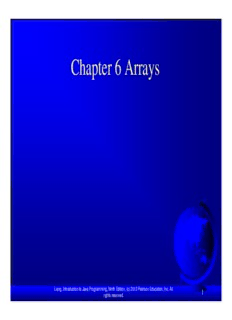
Arrays in Java PDF
Preview Arrays in Java
Chapter 6 Arrays Liang, Introduction to Java Programming, Ninth Edition, (c) 2013 Pearson Education, Inc. All 1 rights reserved. Opening Problem Read one hundred numbers, compute their average, and find out how many numbers are above the average. Liang, Introduction to Java Programming, Ninth Edition, (c) 2013 Pearson Education, Inc. All 2 rights reserved. Solution AnalyzeNumbers Run Run with prepared input Liang, Introduction to Java Programming, Ninth Edition, (c) 2013 Pearson Education, Inc. All 3 rights reserved. Objectives (cid:1) To describe why arrays are necessary in programming (§6.1). (cid:1) To declare array reference variables and create arrays (§§6.2.1–6.2.2). (cid:1) To initialize obtain array size using arrayRefVar.length and know default the values in an array (§6.2.3). (cid:1) To access array elements using indexed variables (§6.2.4). (cid:1) To declare, create, and initialize an array using an array initializer (§6.2.5). (cid:1) To program common array operations (displaying arrays, summing all elements, finding the minimum and maximum elements, random shuffling, and shifting elements) (§6.2.6). (cid:1) To simplify programming using the for-eachfor-each loops (§6.2.7). (cid:1) To apply arrays in the application development (LottoNumbers, DeckOfCards) (§§6.3–6.4). (cid:1) To copy contents from one array to another (§6.5). (cid:1) To develop and invoke methods with array arguments and return values (§§6.6–6.78). (cid:1) To define a method with a variable-length argument list (§6.89). (cid:1) To search elements using the linear (§6.910.1) or binary (§6.910.2) search algorithm. (cid:1) To sort an array using the selection sort approach (§6.1011.1). (cid:1) To sort an array using the insertion sort approach (§6.1011.2). (cid:1) To use the methods in the java.util.Arrays class (§6.1112). Liang, Introduction to Java Programming, Ninth Edition, (c) 2013 Pearson Education, Inc. All 4 rights reserved. Introducing Arrays Array is a data structure that represents a collection of the same types of data. double[] myList = new double[10]; myList reference 5.6 myList[0] myList[1] 4.5 Array reference myList[2] 3.3 variable myList[3] 13.2 myList[4] 4 Array element at myList[5] 34.33 Element value index 5 34 myList[6] 45.45 myList[7] 99.993 myList[8] 11123 myList[9] Liang, Introduction to Java Programming, Ninth Edition, (c) 2013 Pearson Education, Inc. All 5 rights reserved. Declaring Array Variables (cid:1) datatype[] arrayRefVar; Example: double[] myList; (cid:1) datatype arrayRefVar[]; // This style is allowed, but not preferred Example: double myList[]; Liang, Introduction to Java Programming, Ninth Edition, (c) 2013 Pearson Education, Inc. All 6 rights reserved. Creating Arrays arrayRefVar = new datatype[arraySize]; Example: myList = new double[10]; references the first element in the array. myList[0] references the last element in the array. myList[9] Liang, Introduction to Java Programming, Ninth Edition, (c) 2013 Pearson Education, Inc. All 7 rights reserved. Declaring and Creating in One Step (cid:1) datatype[] arrayRefVar = new datatype[arraySize]; double[] myList = new double[10]; (cid:1) datatype arrayRefVar[] = new datatype[arraySize]; double myList[] = new double[10]; Liang, Introduction to Java Programming, Ninth Edition, (c) 2013 Pearson Education, Inc. All 8 rights reserved. The Length of an Array Once an array is created, its size is fixed. It cannot be changed. You can find its size using arrayRefVar.length For example, myList.length returns 10 Liang, Introduction to Java Programming, Ninth Edition, (c) 2013 Pearson Education, Inc. All 9 rights reserved. Default Values When an array is created, its elements are assigned the default value of 0 for the numeric primitive data types, '\u0000' for char types, and false for boolean types. Liang, Introduction to Java Programming, Ninth Edition, (c) 2013 Pearson Education, Inc. All 10 rights reserved.
Description: